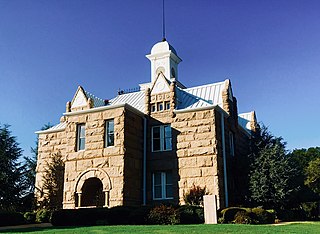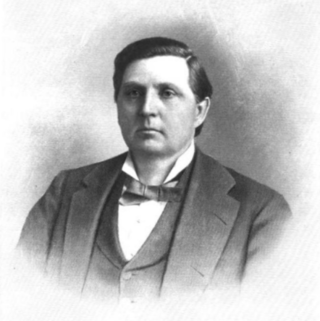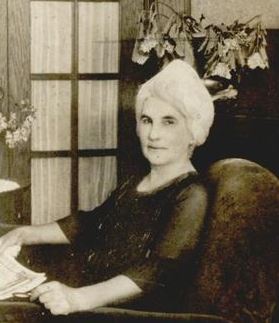
Okmulgee County is a county in the U.S. state of Oklahoma. As of the 2020 census, the population was 36,706. The county seat is Okmulgee. Located within the Muscogee Nation Reservation, the county was created at statehood in 1907. The name Okmulgee is derived from the Hitchita word okimulgi, meaning "boiling waters".

Johnston County is a county located in the U.S. state of Oklahoma. As of the 2020 census, the population was 10,272. Its county seat is Tishomingo. It was established at statehood on November 16, 1907, and named for Douglas H. Johnston, a governor of the Chickasaw Nation.

Tahlequah is a city in Cherokee County, Oklahoma located at the foothills of the Ozark Mountains. It is part of the Green Country region of Oklahoma and was established as a capital of the 19th-century Cherokee Nation in 1839, as part of the new settlement in Indian Territory after the Cherokee Native Americans were forced west from the American Southeast on the Trail of Tears.

Tishomingo is the largest city in, and the county seat of, Johnston County, Oklahoma, United States. The population was 3,101 as of the 2020 Census, an increase of 2.2% over the population of 3,034 reported at the 2010 census. It was the first capital of the Chickasaw Nation, from 1856 until Oklahoma statehood in 1907. The city is home to Murray State College, a community college with an annual enrollment of 3,015 students. Tishomingo is part of the Texoma region.

The Oklahoma State Capitol is the house of government of the U.S. state of Oklahoma. It is the building that houses the Oklahoma Legislature and executive branch offices. It is located along Lincoln Boulevard in Oklahoma City and contains 452,508 square feet of floor area. The present structure includes a dome completed in 2002.

Tishomingo State Park is a public recreation area located in the foothills of the Appalachian Mountains in Tishomingo County, some 45 miles (72 km) northeast of Tupelo, Mississippi. The major feature of the park is Bear Creek Canyon and its generous sandstone outcroppings. Activities in the park include canoeing, rock climbing, fishing, and hiking. The park sits at Milepost 304 of Natchez Trace Parkway, a scenic road operated by the National Park Service that runs directly through the park.

The Chickasaw Nation is a federally recognized Indigenous nation with headquarters in Ada, Oklahoma, in the United States. The Chickasaw Nation descends from an Indigenous population historically located in the southeastern United States, including present-day northern Mississippi, northwestern Alabama, southwestern Kentucky, and western Tennessee. Today, the Chickasaw Nation is the 12th largest Indigenous nation in the United States, with a population exceeding 80,000 citizens, most of whom reside in Oklahoma.

Billy Joe Anoatubby is the 32nd Governor of the Chickasaw Nation, a position he has held since 1987. From 1979 to 1987, Anoatubby served two terms as Lieutenant Governor of the Chickasaw Nation in the administration of Governor Overton James, after being popularly elected to office. He is a member of the Democratic Party.

South Central Oklahoma is an amorphous region in the state of Oklahoma, perhaps encompassing 10 counties. It is centered on the Arbuckle Mountains, an ancient, eroded range traversing some 70 miles (110 km) across the region, and surrounded by rivers and lakes, notably Lake Texoma, Lake Murray and Lake of the Arbuckles. For tourism purposes, the Oklahoma Department of Tourism has more narrowly defined South Central Oklahoma, which they refer to as Chickasaw Country, as being a seven-county region including Pontotoc, Johnston, Marshall, Garvin, Murray, Carter, and Love counties. A ten-county definition might also include Coal, Atoka, and Bryan counties, although the Department of Tourism includes those in Choctaw Country. The Choctaw Nation of Oklahoma covers the eastern third of the region. Its headquarters is in Durant, and its capitol building, now a museum, is in Tuskahoma. The Chickasaw Nation lies within the region, with the tribal capitol building located at Tishomingo and its headquarters in Ada. The Chickasaw Nation, which runs "Chickasawcountry.com"., promotes the idea of Chickasaw Country as the 13 south-central Oklahoma counties that comprise the Chickasaw Nation, being the Tourism Department’s seven counties plus Coal, Bryan, Jefferson, Stephens, Grady, and McClain counties.

The Muscogee Nation, or Muscogee (Creek) Nation, is a federally recognized Native American tribe based in the U.S. state of Oklahoma. The nation descends from the historic Muscogee Confederacy, a large group of indigenous peoples of the Southeastern Woodlands. They commonly refer to themselves as Este Mvskokvlke. Historically, they were often referred to by European Americans as one of the Five Civilized Tribes of the American Southeast.

The Cherokee National Capitol, now the Cherokee National History Museum, is a historic tribal government building in Tahlequah, Oklahoma. Completed in 1869, it served as the capitol building of the Cherokee Nation from 1869 to 1907, when Oklahoma became a state. It now serves as the site of the tribal supreme court and judicial branch. It was designated a National Historic Landmark in 1961 for its role in the Nation's history.

Creek National Capitol, also known as Creek Council House, is a building in downtown Okmulgee, Oklahoma, United States. It was the capitol of the Muscogee (Creek) Nation from 1878 until 1907. They had established their capital at Okmulgee in 1867, after the American Civil War.

Douglas Hancock Cooper Johnston, also known as "Douglas Henry Johnston", was a tribal leader who served as the last elected governor of the Chickasaw Nation from 1898 to 1902. He was re-elected in 1904.

Bloomfield Academy was a Chickasaw school for girls founded in 1852 by the Reverend John Harpole Carr, located in the Chickasaw Nation in Indian Territory, about 3 miles (4.8 km) southeast of the present town of Achille, Oklahoma. A boarding school funded by both the Missouri Conference of the Methodist Church and the government of the Chickasaw Nation, it operated there until 1914, which a major fire destroyed most buildings. Now privately owned, the site of the former academy near Achille was listed on the National Register of Historic Places in 1972.
A Mississippi Landmark is a building officially nominated by the Mississippi Department of Archives and History and approved by each county's chancery clerk. The Mississippi Landmark designation is the highest form of recognition bestowed on properties by the state of Mississippi, and designated properties are protected from changes that may alter the property's historic character. Currently there are 890 designated landmarks in the state. Mississippi Landmarks are spread out between eighty-one of Mississippi's eighty-two counties; only Issaquena County has no such landmarks.

The Chickasaw County Courthouse is a historic governmental building located at 8 East Prospect Street in New Hampton, Iowa, United States. On July 2, 1981, it was added to the National Register of Historic Places. The courthouse is the fourth structure to house court functions and county administration.

The Choctaw Capitol Building is a historic building built in 1884 that housed the government of the Choctaw Nation of Oklahoma from 1884 to 1907. The building is located in Pushmataha County, Oklahoma, two miles north of the community of Tuskahoma.
The Tishomingo City Hall on W. Main St. in Tishomingo, Oklahoma, also known as Bank of the Chickasaw Nation, was built in 1911. It was listed on the National Register of Historic Places in 1975.

Estelle Chisholm Ward was a Chickasaw teacher, journalist, and magazine publisher from Oklahoma. She was active in politics both civic and tribal and was elected as county treasurer of Johnston County, Oklahoma. Ward was the first woman to represent the Chickasaw Nation as a delegate to Washington, DC.

The Chickasaw Capitol Building housed the government of the Chickasaw Nation during its last six years of existence. The government ceased to exist on March 4, 1906, a little more than one year before Indian Territory and Oklahoma Territory combined to form the present state of Oklahoma. The building was sold to Johnston County, Oklahoma, in 1992, which used it as the county courthouse. The Chickasaw Nation repurchased the structure and has turned it into a museum.


















